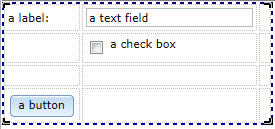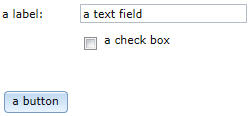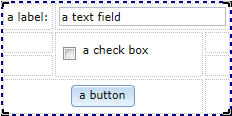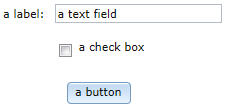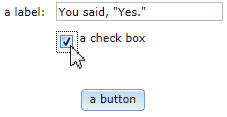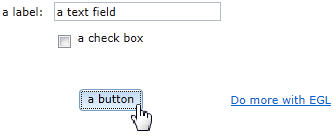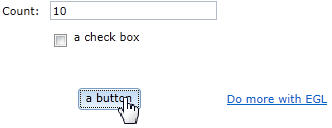Notice: this Wiki will be going read only early in 2024 and edits will no longer be possible. Please see: https://gitlab.eclipse.org/eclipsefdn/helpdesk/-/wikis/Wiki-shutdown-plan for the plan.
Difference between revisions of "EDT:Writing a Rich UI application"
| (26 intermediate revisions by one other user not shown) | |||
| Line 1: | Line 1: | ||
| − | + | This page contains code snippets for Rich UI applications. For background information, see [http://www.eclipse.org/edt/papers/topics/egl_web_technology.html Web technology for EGL Rich UI]. | |
| − | + | You can run each of the snippets that follow: | |
| − | + | #Create an EGL project for '''Web 2.0 client application with services'''. | |
| + | #Copy the content of a given snippet to an EGL file named '''MyHandler''' and place that file in the package named '''client'''. | ||
| + | #Run the handler in the Preview tab. | ||
| + | #Change the content as you see fit and re-run the code. | ||
| + | #Save the content elsewhere if you want to keep your changes, and try the next snippet. | ||
| − | + | Even if you're an efficiency expert, you can play. | |
| − | + | ||
| − | + | ||
| − | + | ||
| − | + | ||
| − | Even if you | + | |
= Create a Handler type of stereotype RUIHandler = | = Create a Handler type of stereotype RUIHandler = | ||
| − | Consider a grid layout on the design surface: | + | Consider a grid layout on the design surface: |
[[Image:Gridlayout initial design.jpg]] | [[Image:Gridlayout initial design.jpg]] | ||
| − | Here is the related code: | + | Here is the related code: |
<source lang="java"> | <source lang="java"> | ||
| Line 46: | Line 45: | ||
</source> | </source> | ||
| − | When you request a Rich UI handler in the IDE, the Rich UI editor includes a grid layout of 3 columns and 4 rows. | + | When you request a Rich UI handler in the IDE, the Rich UI editor includes a grid layout of 3 columns and 4 rows. |
= Declare and display a set of widgets = | = Declare and display a set of widgets = | ||
| Line 56: | Line 55: | ||
The third column is present, but empty. <br> | The third column is present, but empty. <br> | ||
| − | Here is the preview and related code: | + | Here is the preview and related code: |
[[Image:Gridlayout without spanning.jpg]] | [[Image:Gridlayout without spanning.jpg]] | ||
| Line 94: | Line 93: | ||
end | end | ||
end | end | ||
| − | </source> | + | </source> |
= Customize the display = | = Customize the display = | ||
| − | Widgets can span columns or rows: | + | Widgets can span columns or rows: |
[[Image:Gridlayout spanning design.jpg]] | [[Image:Gridlayout spanning design.jpg]] | ||
| Line 138: | Line 137: | ||
horizontalAlignment = GridLayoutLib.Align_Center }, | horizontalAlignment = GridLayoutLib.Align_Center }, | ||
text="a button" }; | text="a button" }; | ||
| − | |||
| − | |||
function start() | function start() | ||
end | end | ||
end | end | ||
| − | |||
</source> | </source> | ||
| − | = Assign and code event handlers = | + | = Assign and code event handlers = |
To assign an event handler: | To assign an event handler: | ||
| − | * Decide on an event such as OnChange or OnClick. | + | *Decide on an event such as OnChange or OnClick. |
| − | * Add a name to the list of event handlers that respond to the event. | + | *Add a name to the list of event handlers that respond to the event. |
| − | * Code the event handler. | + | *Code the event handler. |
| − | Here is the preview: | + | Here is the preview: |
[[Image:Gridlayout checkbox event.jpg]] | [[Image:Gridlayout checkbox event.jpg]] | ||
| Line 165: | Line 161: | ||
text = "a check box", | text = "a check box", | ||
onChange ::= checkBox_response}; | onChange ::= checkBox_response}; | ||
| − | </source> | + | </source> |
If you use the Rich UI editor to change the myCheckBox declaration, you can press Ctrl-1 to add the following stub: | If you use the Rich UI editor to change the myCheckBox declaration, you can press Ctrl-1 to add the following stub: | ||
| Line 172: | Line 168: | ||
function checkBox_response(e Event in) | function checkBox_response(e Event in) | ||
| − | end</source> | + | end</source> |
| − | Here is the updated application: | + | Here is the updated application: |
<source lang="java"> | <source lang="java"> | ||
| Line 195: | Line 191: | ||
title = "MyHandler"} | title = "MyHandler"} | ||
| − | + | ui GridLayout{columns = 3, rows = 4, cellPadding = 4, children =[myLabel, | |
| − | + | myTextField, myCheckBox, myButton]}; | |
| − | + | ||
| − | + | ||
myLabel TextLabel{layoutData = new GridLayoutData{row = 1, column = 1}, text = "a label: "}; | myLabel TextLabel{layoutData = new GridLayoutData{row = 1, column = 1}, text = "a label: "}; | ||
| Line 206: | Line 200: | ||
myCheckBox CheckBox{layoutData = new GridLayoutData{row = 2, column = 2}, | myCheckBox CheckBox{layoutData = new GridLayoutData{row = 2, column = 2}, | ||
| − | text = "a check box", onChange ::= checkBox_response}; | + | text = "a check box", |
| + | |||
| + | /***** reference an event handler for the check box onChange event *****/ | ||
| + | /************************************************************************/ | ||
| + | onChange ::= checkBox_response}; | ||
myButton Button{ layoutData = new GridLayoutData{ row = 4, column = 1, | myButton Button{ layoutData = new GridLayoutData{ row = 4, column = 1, | ||
| Line 216: | Line 214: | ||
end | end | ||
| + | /************** event handler for the check box onChange event **********************/ | ||
| + | /*************************************************************************************/ | ||
function checkBox_response(e event) | function checkBox_response(e event) | ||
myMessage string; | myMessage string; | ||
| Line 226: | Line 226: | ||
end | end | ||
end | end | ||
| − | </source> | + | </source> |
| − | When you are attaching an event handler to a button, you typically use the OnClick event. | + | When you are attaching an event handler to a button, you typically use the OnClick event. |
| − | Here is a preview and the related code, which shows | + | Here is a preview and the related code, which shows one way to add a new widget to the page, but no longer has the check box onChange event: |
[[Image:Gridlayout button event.jpg]] | [[Image:Gridlayout button event.jpg]] | ||
| Line 263: | Line 263: | ||
myCheckBox CheckBox{layoutData = new GridLayoutData{row = 2, column = 2}, | myCheckBox CheckBox{layoutData = new GridLayoutData{row = 2, column = 2}, | ||
| − | text = "a check box" | + | text = "a check box"}; |
myButton Button{ layoutData = new GridLayoutData{ row = 4, column = 1, | myButton Button{ layoutData = new GridLayoutData{ row = 4, column = 1, | ||
horizontalSpan = 2, | horizontalSpan = 2, | ||
horizontalAlignment = GridLayoutLib.Align_Center }, | horizontalAlignment = GridLayoutLib.Align_Center }, | ||
| − | text="a button", onClick ::= button_Response}; | + | text="a button", |
| − | + | ||
| + | /***** reference an event handler for the button onClick event ****/ | ||
| + | /*******************************************************************/ | ||
| + | onClick ::= button_Response}; | ||
function start() | function start() | ||
end | end | ||
| − | + | ||
| − | + | /************** event handler for the button onClick event **************************/ | |
| − | + | /*************************************************************************************/ | |
| − | + | ||
| − | + | ||
| − | + | ||
| − | + | ||
| − | + | ||
| − | + | ||
| − | + | ||
| − | + | ||
function button_response(e event) | function button_response(e event) | ||
ui.appendChildren([myHyperLink]); | ui.appendChildren([myHyperLink]); | ||
end | end | ||
| − | + | ||
| + | /************** a new widget definition *********************************************/ | ||
myHyperlink HyperLink | myHyperlink HyperLink | ||
{ | { | ||
| Line 296: | Line 292: | ||
}; | }; | ||
end | end | ||
| − | </source> | + | </source> |
| − | The code now includes a variable named <code>counter</code>, for use in the next section. | + | The code now includes a variable named <code>counter</code>, for use in the next section. |
= Write the on-construction function = | = Write the on-construction function = | ||
| − | The on-construction function is typically named <code>start</code>. The function might update the widgets, initialize variables, invoke a service, or schedule a job. | + | The on-construction function is typically named <code>start</code>. The function might update the widgets, initialize variables, invoke a service, or schedule a job. |
| − | The example function changes a label text, initializes a counter, and schedules a job that increments the counter. The job begins when the on-construction ends. The job ends when the user clicks the button. | + | The example function changes a label text, initializes a counter, and schedules a job that increments the counter. The job begins when the on-construction ends. The job ends when the user clicks the button. |
| − | Here is the preview and related code: | + | Here is the preview and related code: |
[[Image:Gridlayout job.jpg]] | [[Image:Gridlayout job.jpg]] | ||
| − | + | <br> <source lang="java"> | |
| − | <source lang="java"> | + | |
package client; | package client; | ||
| Line 331: | Line 326: | ||
title = "MyHandler"} | title = "MyHandler"} | ||
| − | counter int; | + | /******** variable for use by the new job **********/ |
| − | + | /***************************************************/ | |
| + | counter int; | ||
| + | |||
ui GridLayout{columns = 3, rows = 4, cellPadding = 4, children =[myLabel, | ui GridLayout{columns = 3, rows = 4, cellPadding = 4, children =[myLabel, | ||
myTextField, myCheckBox, myButton]}; | myTextField, myCheckBox, myButton]}; | ||
| Line 342: | Line 339: | ||
myCheckBox CheckBox{layoutData = new GridLayoutData{row = 2, column = 2}, | myCheckBox CheckBox{layoutData = new GridLayoutData{row = 2, column = 2}, | ||
| − | text = "a check box" | + | text = "a check box"}; |
myButton Button{ layoutData = new GridLayoutData{ row = 4, column = 1, | myButton Button{ layoutData = new GridLayoutData{ row = 4, column = 1, | ||
| Line 349: | Line 346: | ||
text="a button", onClick ::= button_Response}; | text="a button", onClick ::= button_Response}; | ||
| + | |||
| + | /********** declare the new job ***********************************/ | ||
| + | /*******************************************************************/ | ||
doThis Job{runFunction = myRunFunction}; | doThis Job{runFunction = myRunFunction}; | ||
| + | |||
| + | /********** create the run function for that job *******************/ | ||
| + | /*******************************************************************/ | ||
function myRunFunction() | function myRunFunction() | ||
counter = counter + 1; | counter = counter + 1; | ||
| Line 356: | Line 359: | ||
end | end | ||
| + | /************ expand the on-construction function ******************/ | ||
| + | /*******************************************************************/ | ||
function start() | function start() | ||
counter = 0; | counter = 0; | ||
| Line 362: | Line 367: | ||
end | end | ||
| − | |||
| − | |||
| − | |||
| − | |||
| − | |||
| − | |||
| − | |||
| − | |||
| − | |||
| − | |||
function button_response(e event) | function button_response(e event) | ||
| + | |||
| + | /****** cancel the job run when the user clicks the button *******/ | ||
| + | /*****************************************************************/ | ||
doThis.cancel(); | doThis.cancel(); | ||
| + | |||
ui.appendChildren([myHyperLink]); | ui.appendChildren([myHyperLink]); | ||
end | end | ||
| Line 385: | Line 384: | ||
}; | }; | ||
end | end | ||
| − | </source> | + | </source> |
| + | <br> | ||
| − | + | <br> | |
| − | + | ||
<br> <br> <br><br> ♦ [[EDT:Code snippets|Code snippets main page]] <br> | <br> <br> <br><br> ♦ [[EDT:Code snippets|Code snippets main page]] <br> | ||
[[Category:EDT]] | [[Category:EDT]] | ||
Latest revision as of 14:49, 6 March 2012
This page contains code snippets for Rich UI applications. For background information, see Web technology for EGL Rich UI.
You can run each of the snippets that follow:
- Create an EGL project for Web 2.0 client application with services.
- Copy the content of a given snippet to an EGL file named MyHandler and place that file in the package named client.
- Run the handler in the Preview tab.
- Change the content as you see fit and re-run the code.
- Save the content elsewhere if you want to keep your changes, and try the next snippet.
Even if you're an efficiency expert, you can play.
Contents
Create a Handler type of stereotype RUIHandler
Consider a grid layout on the design surface:
Here is the related code:
package client; import org.eclipse.edt.rui.widgets.GridLayout; handler MyHandler type RUIhandler{ // sets one or more widgets at the root of the widget tree. initialUI =[ui], // specifies the function that runs initially and without user interaction. onConstructionFunction = start, // identifies the CSS file that helps you to design the page. cssFile = "css/MyProject.css", // sets the title that is displayed at the top of your browser or browser tab. title = "MyHandler"} ui GridLayout{columns = 3, rows = 4, cellPadding = 4, children =[]}; function start() end end
When you request a Rich UI handler in the IDE, the Rich UI editor includes a grid layout of 3 columns and 4 rows.
Declare and display a set of widgets
The grid layout now has four widgets in the first two columns:
The third column is present, but empty.
Here is the preview and related code:
package client; import org.eclipse.edt.rui.widgets.Button; import org.eclipse.edt.rui.widgets.CheckBox; import org.eclipse.edt.rui.widgets.GridLayout; import org.eclipse.edt.rui.widgets.GridLayoutData; import org.eclipse.edt.rui.widgets.GridLayoutLib; import org.eclipse.edt.rui.widgets.TextField; import org.eclipse.edt.rui.widgets.TextLabel; import eglx.ui.rui.RUIHandler; handler MyHandler type RUIhandler{ initialUI =[ui], onConstructionFunction = start, cssFile = "css/MyProject.css", title = "MyHandler"} ui GridLayout{columns = 3, rows = 4, cellPadding = 4, children =[myLabel, myTextField, myCheckBox, myButton]}; myLabel TextLabel{ layoutData = new GridLayoutData{ row = 1, column=1}, text = "a label: " }; myTextField TextField{ layoutData = new GridLayoutData{ row = 1, column = 2}, text = "a text field"}; myCheckBox CheckBox{ layoutData = new GridLayoutData{ row = 2, column = 2 }, text="a check box" }; myButton Button{ layoutData = new GridLayoutData{ row = 4, column = 1 }, text="a button" }; function start() end end
Customize the display
Widgets can span columns or rows:
Here is the preview and related code:
package client; import org.eclipse.edt.rui.widgets.Button; import org.eclipse.edt.rui.widgets.CheckBox; import org.eclipse.edt.rui.widgets.GridLayout; import org.eclipse.edt.rui.widgets.GridLayoutData; import org.eclipse.edt.rui.widgets.GridLayoutLib; import org.eclipse.edt.rui.widgets.TextField; import org.eclipse.edt.rui.widgets.TextLabel; import eglx.ui.rui.RUIHandler; handler MyHandler type RUIhandler{ initialUI =[ui], onConstructionFunction = start, cssFile = "css/MyProject.css", title = "MyHandler"} ui GridLayout{columns = 3, rows = 4, cellPadding = 4, children =[myLabel, myTextField, myCheckBox, myButton]}; myLabel TextLabel{ layoutData = new GridLayoutData{ row = 1, column=1}, text = "a label: " }; myTextField TextField{ layoutData = new GridLayoutData{ row = 1, column = 2, horizontalSpan = 2 }, text = "a text field"}; myCheckBox CheckBox{ layoutData = new GridLayoutData{ row = 2, column = 2, verticalSpan = 2 }, text="a check box" }; myButton Button{ layoutData = new GridLayoutData{ row = 4, column = 1, horizontalSpan = 2, horizontalAlignment = GridLayoutLib.Align_Center }, text="a button" }; function start() end end
Assign and code event handlers
To assign an event handler:
- Decide on an event such as OnChange or OnClick.
- Add a name to the list of event handlers that respond to the event.
- Code the event handler.
Here is the preview:
Here is the changed declaration of myCheckBox:
myCheckBox CheckBox{layoutData = new GridLayoutData{row = 2, column = 2}, text = "a check box", onChange ::= checkBox_response};
If you use the Rich UI editor to change the myCheckBox declaration, you can press Ctrl-1 to add the following stub:
function checkBox_response(e Event in) end
Here is the updated application:
package client; import org.eclipse.edt.rui.widgets.Button; import org.eclipse.edt.rui.widgets.CheckBox; import org.eclipse.edt.rui.widgets.GridLayout; import org.eclipse.edt.rui.widgets.GridLayoutData; import org.eclipse.edt.rui.widgets.GridLayoutLib; import org.eclipse.edt.rui.widgets.TextField; import org.eclipse.edt.rui.widgets.TextLabel; import eglx.ui.rui.Event; import eglx.ui.rui.RUIHandler; handler MyHandler type RUIhandler{ initialUI =[ui], onConstructionFunction = start, cssFile = "css/MyProject.css", title = "MyHandler"} ui GridLayout{columns = 3, rows = 4, cellPadding = 4, children =[myLabel, myTextField, myCheckBox, myButton]}; myLabel TextLabel{layoutData = new GridLayoutData{row = 1, column = 1}, text = "a label: "}; myTextField TextField{layoutData = new GridLayoutData{row = 1, column = 2}, text = "a text field"}; myCheckBox CheckBox{layoutData = new GridLayoutData{row = 2, column = 2}, text = "a check box", /***** reference an event handler for the check box onChange event *****/ /************************************************************************/ onChange ::= checkBox_response}; myButton Button{ layoutData = new GridLayoutData{ row = 4, column = 1, horizontalSpan = 2, horizontalAlignment = GridLayoutLib.Align_Center }, text="a button" }; function start() end /************** event handler for the check box onChange event **********************/ /*************************************************************************************/ function checkBox_response(e event) myMessage string; if (myCheckBox.selected == true) myMessage = "You said, \"Yes.\""; else myMessage = "You said, \"No.\""; end myTextField.text = myMessage; end end
When you are attaching an event handler to a button, you typically use the OnClick event.
Here is a preview and the related code, which shows one way to add a new widget to the page, but no longer has the check box onChange event:
package client; import org.eclipse.edt.rui.widgets.Button; import org.eclipse.edt.rui.widgets.CheckBox; import org.eclipse.edt.rui.widgets.GridLayout; import org.eclipse.edt.rui.widgets.GridLayoutData; import org.eclipse.edt.rui.widgets.GridLayoutLib; import org.eclipse.edt.rui.widgets.HyperLink; import org.eclipse.edt.rui.widgets.TextField; import org.eclipse.edt.rui.widgets.TextLabel; import eglx.ui.rui.Event; import eglx.ui.rui.RUIHandler; handler MyHandler type RUIhandler{ initialUI =[ui], onConstructionFunction = start, cssFile = "css/MyProject.css", title = "MyHandler"} ui GridLayout{columns = 3, rows = 4, cellPadding = 4, children =[myLabel, myTextField, myCheckBox, myButton]}; myLabel TextLabel{layoutData = new GridLayoutData{row = 1, column = 1}, text = "a label: "}; myTextField TextField{layoutData = new GridLayoutData{row = 1, column = 2}, text = "a text field"}; myCheckBox CheckBox{layoutData = new GridLayoutData{row = 2, column = 2}, text = "a check box"}; myButton Button{ layoutData = new GridLayoutData{ row = 4, column = 1, horizontalSpan = 2, horizontalAlignment = GridLayoutLib.Align_Center }, text="a button", /***** reference an event handler for the button onClick event ****/ /*******************************************************************/ onClick ::= button_Response}; function start() end /************** event handler for the button onClick event **************************/ /*************************************************************************************/ function button_response(e event) ui.appendChildren([myHyperLink]); end /************** a new widget definition *********************************************/ myHyperlink HyperLink { layoutData = new GridLayoutData{row = 4, column = 3}, text = "Do more with EGL", target = "_blank", href = "http://www.eclipse.org/edt/#gettingstarted" }; end
The code now includes a variable named counter, for use in the next section.
Write the on-construction function
The on-construction function is typically named start. The function might update the widgets, initialize variables, invoke a service, or schedule a job.
The example function changes a label text, initializes a counter, and schedules a job that increments the counter. The job begins when the on-construction ends. The job ends when the user clicks the button.
Here is the preview and related code:
package client; import org.eclipse.edt.rui.widgets.Button; import org.eclipse.edt.rui.widgets.CheckBox; import org.eclipse.edt.rui.widgets.GridLayout; import org.eclipse.edt.rui.widgets.GridLayoutData; import org.eclipse.edt.rui.widgets.GridLayoutLib; import org.eclipse.edt.rui.widgets.HyperLink; import org.eclipse.edt.rui.widgets.TextField; import org.eclipse.edt.rui.widgets.TextLabel; import eglx.ui.rui.Event; import eglx.ui.rui.RUIHandler; handler MyHandler type RUIhandler{ initialUI =[ui], onConstructionFunction = start, cssFile = "css/MyProject.css", title = "MyHandler"} /******** variable for use by the new job **********/ /***************************************************/ counter int; ui GridLayout{columns = 3, rows = 4, cellPadding = 4, children =[myLabel, myTextField, myCheckBox, myButton]}; myLabel TextLabel{layoutData = new GridLayoutData{row = 1, column = 1}, text = "a label: "}; myTextField TextField{layoutData = new GridLayoutData{row = 1, column = 2}, text = "a text field"}; myCheckBox CheckBox{layoutData = new GridLayoutData{row = 2, column = 2}, text = "a check box"}; myButton Button{ layoutData = new GridLayoutData{ row = 4, column = 1, horizontalSpan = 2, horizontalAlignment = GridLayoutLib.Align_Center }, text="a button", onClick ::= button_Response}; /********** declare the new job ***********************************/ /*******************************************************************/ doThis Job{runFunction = myRunFunction}; /********** create the run function for that job *******************/ /*******************************************************************/ function myRunFunction() counter = counter + 1; myTextField.text = counter; end /************ expand the on-construction function ******************/ /*******************************************************************/ function start() counter = 0; myLabel.text = "Count:"; doThis.repeat(1000); end function button_response(e event) /****** cancel the job run when the user clicks the button *******/ /*****************************************************************/ doThis.cancel(); ui.appendChildren([myHyperLink]); end myHyperlink HyperLink { layoutData = new GridLayoutData{row = 4, column = 3}, text = "Do more with EGL", target = "_blank", href = "http://www.eclipse.org/edt/#gettingstarted" }; end

